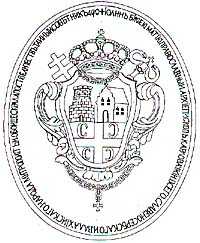Declaratory Rescript of the Illyrian Nation
Declaratory Rescript of the Illyrian Nation (Latin: Rescriptum Declaratorium Illyricae Nationis; Serbian Cyrillic: Деклараторни рескрипт илирске нације, or shortened: Деклараторија) was issued on 16 July 1779 by Maria Theresa, Dowager-Empress and Queen of Hungary (1740-1780).[1] It was a royal rescript, issued in response to a series of petitions made by Eastern Orthodox subjects of the Habsburg Monarchy, regarding the regulation of their religious freedom and ecclesiastical autonomy. The document was the result of a process, initiated by previously issued Regulamentum privilegiorum (1770) and Regulamentum Illyricae Nationis (1777), both of them replaced by the royal rescript of 1779.[2]
.jpg)
The Rescript

The Rescript contained detailed regulations on the organization of the Metropolitanate of Karlovci, an autonomous ecclesiastical province of Eastern Orthodox Christians in the Habsburg Monarchy, who were mainly Serbs and Romanians. Since the end of the 17th century, the archaic term Illyrians was used by the state administration in a classicizing manner, at first as a designation for Serbs,[3] and later for all Eastern Orthodox subjects, including Serbs, Romanians and some other minor groups.[4]
During the reign of Maria Theresa (1740-1780), several assemblies of Habsburg Serbs were held, with royal consent, sending their grievances and petitions to the Habsburg court. In response to that, the Rescript of 1779 regulated, on some issues restrictively, many important questions, from the procedures regarding the elections of Eastern Orthodox bishops, to the management of dioceses, parishes and monasteries. With small changes, the Rescript was upheld in force until it was replaced by the "Royal Rescript" issued on 10 August 1868.[5]
See also
- Great Migrations of the Serbs
- Arsenije III Crnojević
- Arsenije IV Jovanović
- Metropolitanate of Karlovci
References
- Martin & Petit 1907, p. 781-850.
- Ćirković 2004, p. 166-167.
- Lins 1910, p. 664.
- Bocşan 2015, p. 243–258.
- Ćirković 2004, p. 196-197.
Sources
- Bocşan, Nicolae (2015). "Illyrian privileges and the Romanians from the Banat" (PDF). Banatica. 25: 243–258.CS1 maint: ref=harv (link)
- Ćirković, Sima (2004). The Serbs. Malden: Blackwell Publishing.CS1 maint: ref=harv (link)
- Lins, Joseph (1910). "Illyria". The Catholic Encyclopedia. 7. New York: Robert Appleton Company. pp. 663–664.CS1 maint: ref=harv (link)
- Martin, Joannes Baptista; Petit, Ludovicus, eds. (1907). "Serborum in Hungaria degentium synodi et constitutiones ecclesiasticae". Sacrorum conciliorum nova et amplissima collectio. 39. Parisiis: Huberti Welter, Bibliopolae. pp. 497–956.CS1 maint: ref=harv (link)
- Pavlovich, Paul (1989). The History of the Serbian Orthodox Church. Serbian Heritage Books.CS1 maint: ref=harv (link)
- Radić, Radmila (2007). "Serbian Christianity". The Blackwell Companion to Eastern Christianity. Malden, MA: Blackwell Publishing. pp. 231–248.CS1 maint: ref=harv (link)
- Todorović, Jelena (2006). An Orthodox Festival Book in the Habsburg Empire: Zaharija Orfelin's Festive Greeting to Mojsej Putnik (1757). Aldershot: Ashgate Publishing.CS1 maint: ref=harv (link)
External links
- Lins, Joseph (1910). "Illyria". The Catholic Encyclopedia. New Advent.CS1 maint: ref=harv (link)